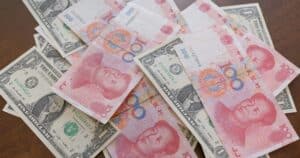Just about everyone knows that the price of gold is constantly changing, but who actually sets the price of gold? While the price is ultimately determined by supply and demand, the London Gold Fixing Rate is the benchmark for the price of gold and can be used by investors to determine the current market price for the price of gold.
What Is The London Gold Fix?
The London Gold Fix (or just Gold Fix) is the benchmark for the gold bullion price on the world market. In this process, the gold dealers of the five largest London bullion banks set a common transaction price for a large pool of gold buy and sell orders.
The Start Of The Gold Fix
Originally founded as The London Gold Market Fixing Ltd, the Gold Fix dates back to 1919, when five of London’s leading banks met daily at Nathan Mayer Rothschild & Sons. They determined supply and demand in the gold market and, based on these factors, set a mutually agreed price that would serve as a reference point for the market to buy or sell gold bullion.
These five original banks included N. M. Rothschild & Sons, Barclays Bank PLC, Deutsche Bank AG, HSBC Bank USA NA and Société Générale SA.
The London Gold Fix We Know Today
From the first meeting in 1919 to the present, the Gold Fix has undergone several changes. In 1968, the system was officially renamed The London Gold Fix to reflect its purpose as the official pricing mechanism for gold trading.
Participating banks currently include HSBC, Barclays, Societe Generale, Bank of China International, and ScotiaMocatta. The process has also been refined as technology has advanced, for example, by introducing electronic trading systems that ensure accurate and rapid daily price discovery.
How The London Gold Fix Establishes Gold Prices
Instead of meeting in person, the proceedings now take place twice a day, Monday through Friday, via a special conference line. The first time is at 10:30 am (Morning Fix) and then again at 3 pm (Afternoon Fix). The AM Fix is used by large gold owners such as refiners and miners to value their holdings, and the PM Fix is used by most central banks to set a price for their gold bullion holdings.
During these times, banks submit bids to set two benchmark prices – one for buying and one for selling. These bids are submitted in two rounds.
In the first round, each bank submits a bid and offer for how much it’s willing to buy or sell gold at that time. In the second round, the actual price of gold is determined. An average price is calculated from these bids and offers, which serves as a benchmark for the price of gold on that day.
The Fixing Process
The gold fixing chairman begins the fixing process by announcing a price, usually close to the previous day’s spot price. Based on this price, participating banks aggregate all orders (buys and sells) they receive and inform the chairman of the net amount of gold they would buy or sell at the proposed price.
Once the initial price is determined, the participating banks review their respective buy and sell orders. This includes checking existing orders from other banks or customers who wish to buy gold.
They then check to see if the net amount of gold to be bought or sold matches. If not, the chairman adjusts the price accordingly until there is a balance between the buy and sell quantities. Once this equilibrium is reached, the final agreed price can be used as a benchmark for settling trades between all parties involved – including participating banks and external customers.
The gold fix serves as an independent price source, so no one knows what the price will be before it is announced, making it ideal for the accurate and fair valuation of gold investments.
Who Participates In The London Gold Fix?
Participation in the London Gold Fix is limited to the five major bullion banks that comprise the London Gold Fixing Board. In addition to the bullion banks, however, several other institutions play a role in the gold market.
Bankers
Bankers are directly involved in the process of London gold fixing. They use their financial expertise to assess the current market situation and submit bids daily at an agreed time during the gold fixing session.
This helps to establish an accurate price that reflects supply and demand conditions as closely as possible so that buyers and sellers can transact with confidence in the knowledge that they’re receiving fair value for their assets.
Brokers
Brokers play an important role in setting up deals between buyers and sellers. They act as middlemen, taking orders from buyers and finding willing sellers to complete a deal.
Brokers provide liquidity in the market by trading for their own accounts. This means that they buy and sell gold without having customers who have already placed orders for it, which helps keep prices stable and ensures that there is always someone willing to buy or sell at a given time.
Trading Houses
Trading houses are important players that provide liquidity and create a platform for transactions. They act as intermediaries between buyers and sellers by providing access to global markets at competitive prices and buying and selling gold on behalf of their clients.
They also provide guidance on market trends and help investors make informed decisions when buying or selling gold. Trading houses help protect investors from price volatility by hedging against the risks associated with volatile markets.
Gold Refiners
Refiners are an important part of the gold industry. They process raw ore into the final product, bars or coins, and customers receive products that meet their expectations for quality and purity. They help maintain confidence in gold as a commodity by ensuring that all products on the market have been tested and verified.
Refiners also help ensure fair pricing by setting benchmark prices for the London gold fixing. Their work is essential to the efficient and fair stabilization of global gold markets.
Other Factors That Affect Gold Prices
While the London Gold Fixing Rate sets the benchmark for the spot price of gold, other factors influence how much buyers and investors have to pay per ounce.
Supply And Demand
The complex interaction between supply and demand largely determines the price of gold. Supply dynamics, such as mine production, recycling, and central bank activity, can affect the amount of gold available in the market.
At the same time, factors such as investment demand (e.g., gold IRAs or futures contracts), jewelry consumption (e.g., wedding rings and necklaces), and industrial use (e.g., electronics manufacturing) can influence the extent to which people want to buy gold.
Together, these two forces determine what price buyers are willing to pay and how much producers can charge for their products. This price is ultimately reflected in the daily London gold fixing rate.
Inflation And Interest Rates
Inflation and rising interest rates are other economic factors that affect the price of gold. When inflation increases, the purchasing power of a currency decreases, and gold tends to increase in value to hedge against it.
Rising interest rates mean that other investments compete that can offer higher returns than gold. As a result of this increased opportunity cost of holding gold, its price could fall due to lower demand.
Geopolitical Tensions
Geopolitical tensions can significantly impact the price of gold, as investors prefer physical assets. These assets are seen as safe havens outside of volatile equity markets that can be affected by political unrest and economic instability.
When geopolitical concerns arise, people often shift their investments into gold to hedge against potential financial losses resulting from a turbulent market environment. This increased demand drives up the price of gold, making it an attractive investment during times of geopolitical tension and volatility.
Invest In Gold & Silver With Noble Gold Investments
Now that you better understand when and how the spot price of gold is determined, hopefully, you can make informed decisions about investing in gold.
If you’re interested in learning more about investing in physical gold and silver or saving for retirement in a tax-deferred gold IRA, our team is standing by to answer your questions. Call us at (877) 646-5347.







